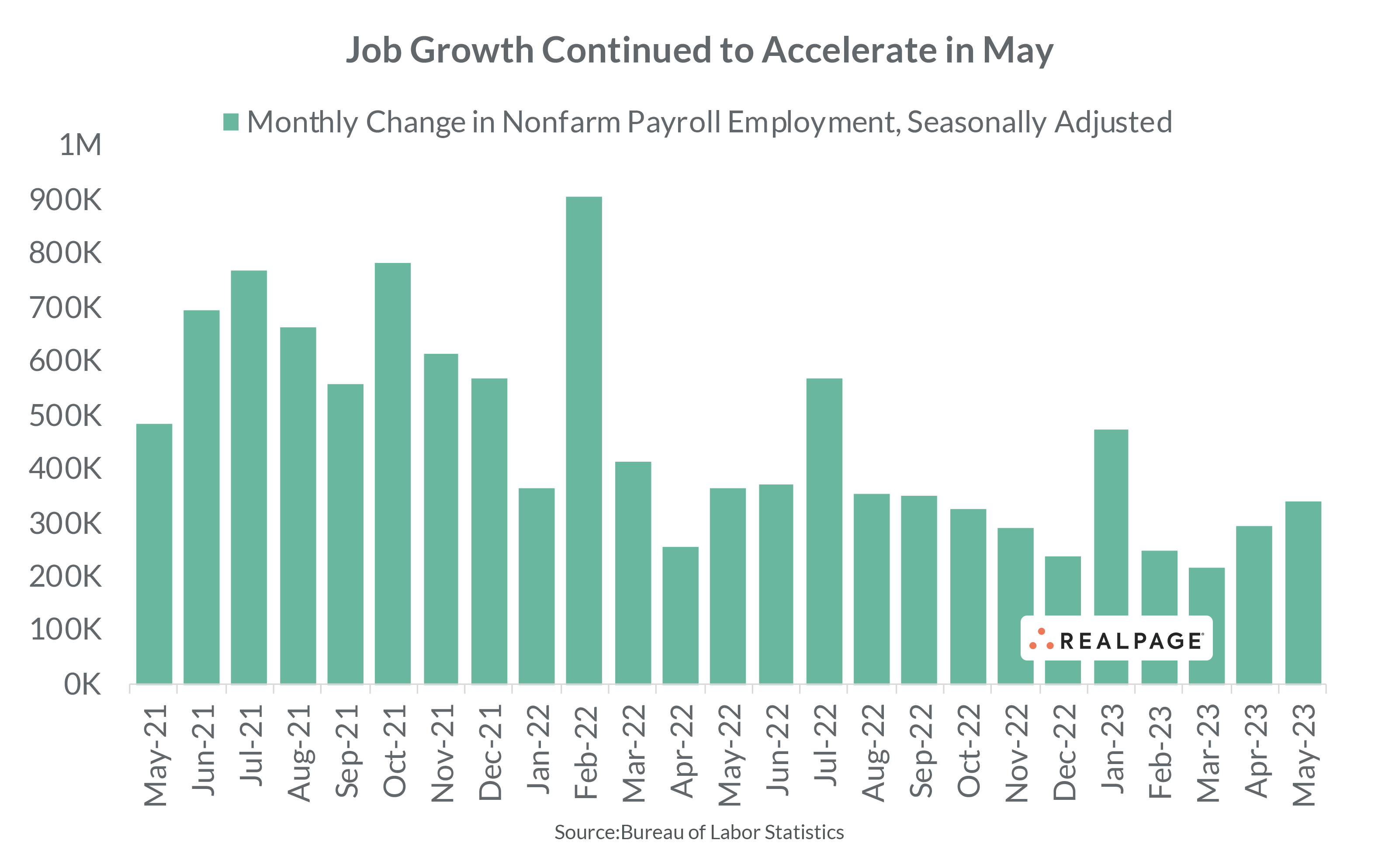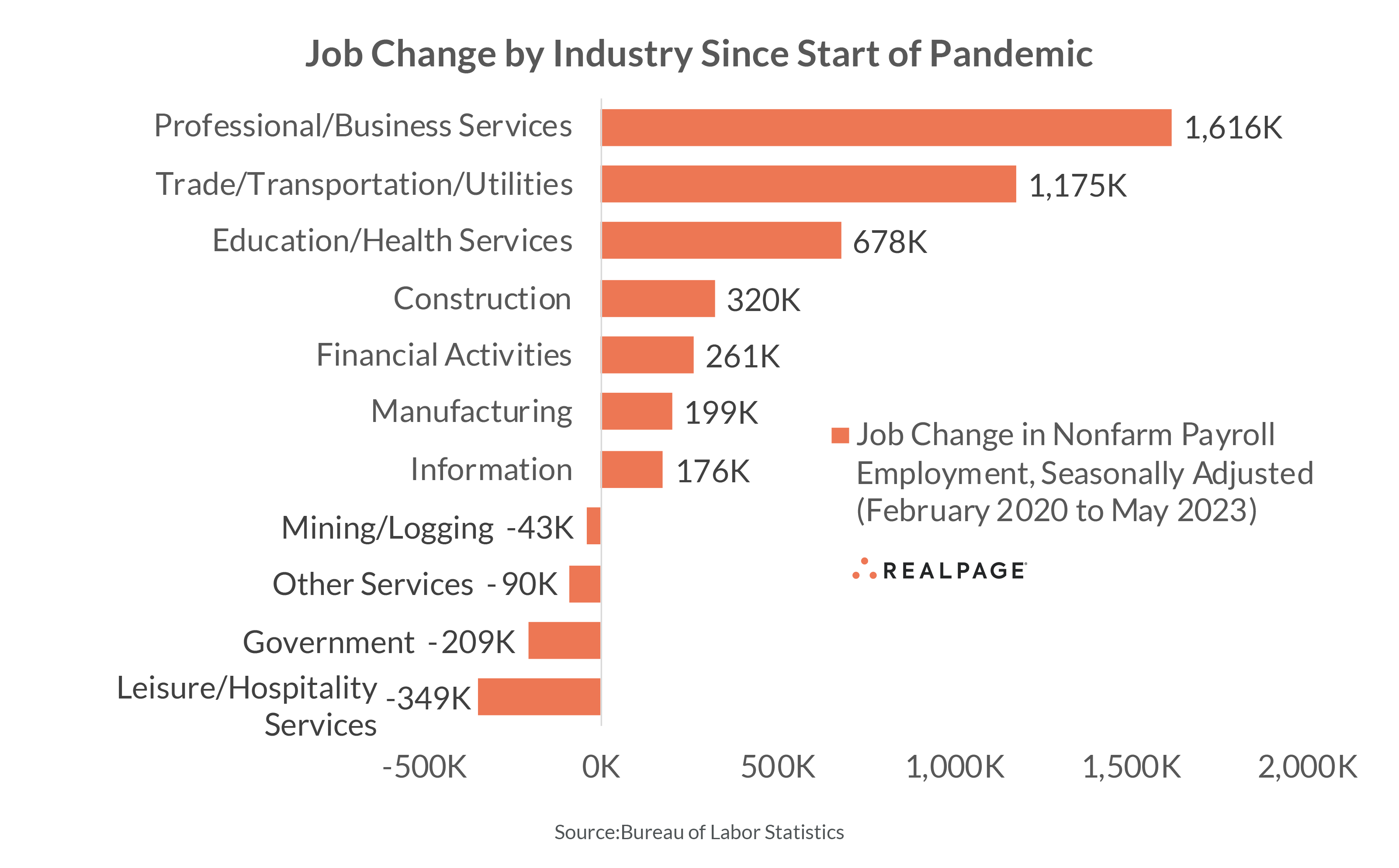Job growth in the U.S. continued to accelerate in May amid recent layoffs in the technology industry, stress in the banking system, and historic interest rate hikes. Despite rising interest rates, the economy is not cooling nearly as fast as the Fed would desire.
The Fed has imposed 10 rate hikes since March 2022 which has taken the federal funds rate to a 16-year high of more than 5%. The pace of hiring is continuing to put upward pressure on wages and inflation, but pay increases are falling short of rising prices. While the labor market outlook is uncertain, job growth remains robust. There could be warning signs on the horizon, as unemployment jumped at one of the fastest paces since early in the pandemic, and yet, the rate remains among historically low levels.
Employers’ steady demand for labor added roughly 339,000 employees to payrolls in May 2023, according to the Bureau of Labor Statistics (BLS). That was the strongest month-over-month gain since January 2023. The nation’s recent job additions were well ahead of economist’s projections (180,000 jobs) and well above April’s gain of 294,000 jobs.
While recent job gains are slightly below the monthly average of around 399,000 jobs added in 2022, employers are continuing to hire more workers than they did prior to the pandemic. From 2015 to 2019, the U.S. economy added an average of roughly 190,000 jobs each month. On an annual basis, the nation gained nearly 4.1 million jobs in May 2023. Although down from the annual gains recorded throughout much of 2021 and 2022, that was well above the average of around 2.4 million jobs added annually from 2015 to 2019.
Upward revisions to March 2023 data showed 52,000 more jobs were added than previously reported, up to 217,000 jobs. The April 2023 job growth number was also revised up, increasing by 41,000 jobs to a total of 294,000 jobs. With these revisions, employment gains in March and April combined were 93,000 higher than previously reported.
The U.S. economy has recovered all the net jobs lost during the COVID-19 pandemic. As of May, the nation had over 3.7 million more jobs (+2.5%) compared to the pre-pandemic employment level from February 2020.
Jobs by Industry
May job growth was seen across most major industry sectors, but most notably in the Education and Health Services industry (+97,000 jobs). Solid gains were also recorded in Professional and Business Services (+64,000 jobs), Government (+56,000 jobs), Leisure and Hospitality Services (+48,000 jobs), Trade, Transportation and Utilities (+37,000 jobs) and Construction (+25,000 jobs). The only two industries to record job losses in May were Information (-9,000 jobs) and Manufacturing (-2,000 jobs).
Most major industries have recovered all the jobs lost during the COVID-19 pandemic downturn. Professional and Business Services has seen the best recovery, with today’s job count coming in more than 1.6 million positions ahead of February 2020 numbers. Trade, Transportation and Utilities is also well ahead of pre-pandemic norms, with employment up by nearly 1.2 million jobs.
Alternatively, some of the harder-hit sectors remain below pre-pandemic job counts. Despite recent gains, employment in the Leisure and Hospitality Services sector is still well below pre-pandemic employment counts, by roughly 349,000 workers. The Government sector is about 209,000 jobs behind February 2020 levels. Other industry sectors yet to recover all jobs lost during the COVID-19 downturn include Other Services (-90,000 jobs) and Mining and Logging (-43,000 jobs).
Unemployment
The unemployment rate (U3 or headline unemployment rate which is seasonally adjusted) in May clocked in at 3.7%, up from the 3.4% rate in April which matched the five-decade low recorded in January. Since March 2022, the unemployment rate has been in a narrow range of 3.4% to 3.7%. At the onset of the pandemic, the unemployment rate climbed to 14.7% in April 2020. Prior to the pandemic, the unemployment rate clocked in at 3.5% to 5.7% from 2015 to 2019, averaging 4.4% during that period.
The total number of unemployed in the U.S. rose by 440,000 to roughly 6.1 million in May.
The unemployment rate for adult men increased 20 basis points (bps) from April to May, rising to 3.5%. The unemployment rate for adult women also rose 20 bps, to 3.3%. Meanwhile, the unemployment rate for teenagers climbed 110 bps from 9.2% in April to 10.3% in May.
Average Hourly Earnings
Average hourly earnings among employees on private nonfarm payrolls rose $0.11 (+0.3%) from April to May. That monthly increase took average hourly earnings to $33.44 in May. On an annual basis, average hourly earnings were up $1.38, a 4.3% increase year-over-year. However, overall wage growth is not keeping up with rising prices, as the Consumer Price Index (CPI) rose 4.9% in the year-ending April. The Fed’s target for inflation is currently at 2%.
Wage growth over the past year varied by industry. The largest increases in earnings from May 2022 to May 2023 were recorded among workers in Mining and Logging (6.3%), Leisure and Hospitality Services (5.5%), Information (5.3%) and Construction (5.1%). The smallest increases were among employees in Education and Health Services (3.8%), Financial Activities (3.9%) and Manufacturing (4.1%).













